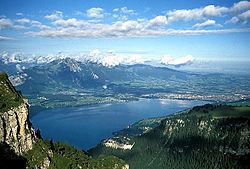Location Canton of Berne Surface elevation 558 m Length 17.5 km | Primary inflows Catchment area 2,500 km (970 sq mi) Volume 6.5 km³ Area 48.3 km² | |
 | ||
Type freshwater fjord, recent regulation Similar Lake Brienz, Jungfrau, Aare, Alps, Niesen | ||
Swisshut b b at lake thun switzerland
Lake Thun (German: Thunersee) is an Alpine lake in the Bernese Oberland in Switzerland named after the city of Thun, on its northern shore.
Contents
Map of Lake Thun, Switzerland
The lake was created after the last glacial period. After the 10th century, it split from Lake Brienz, before which the two lakes were combined, as Wendelsee ("Lake Wendel"). The culminating point of the lake's drainage basin is the Finsteraarhorn at 4,274 metres above sea level.
Lake Thun's approximate 2,500 km² catchment area frequently causes local flooding after heavy rainfalls. This occurs because the river Aare (German: Aare), which drains Lake Thun, has only limited capacity to handle the excess runoff. The lake is fed by water from Lake Brienz to the southeast, which is 6 metres higher than Lake Thun, and various streams in the Oberland, including the Kander.
In 1835, passenger ships began operating on the lake. Ten passenger ships, operated by the local railway company BLS AG, serve the towns of Interlaken and Thun; the Interlaken ship canal and Thun ship canal connect the lake to Interlaken West railway station and Thun railway station respectively.
Following World War II and up until 1964, the Swiss Government disposed of unused munitions into Lake Thun. The quantity of munitions dumped is reported to be from 3,000 to more than 9,020 tons.
